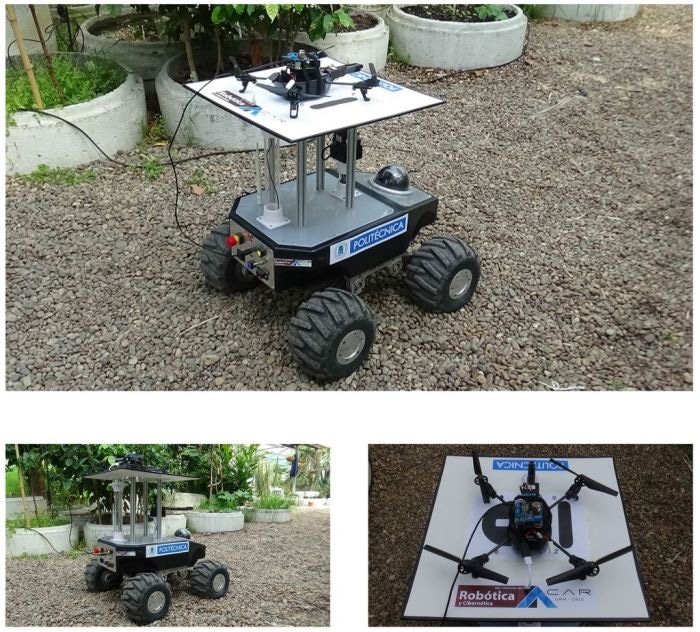Nov 8 2016
Researchers from UPM use a multi-robot team to measure environmental variables of greenhouses and to ease the continuous monitoring of crop conditions.
 Team of robots used in the testing. (Credits: CAR (UPM-CSIC))
Team of robots used in the testing. (Credits: CAR (UPM-CSIC))
Recently, researchers from the Robotics & Cybernetics Research Group (RobCib) at Centre for Automation and Robotics (CAR), a joint centre between Universidad Politécnica de Madrid (UPM) and Spanish National Research Council (CSIC), have used a team compound by a terrestrial robot and an aerial robot to measure temperature, humidity, luminosity and carbon dioxide concentration in the ground and at different heights. The information about the greenhouse collected by both robots allows us to know the crop conditions at any moment and to detect problems before it is too late.
What are those robots doing moving among the plants? This is a question that in a near future people will ask when visiting a greenhouse. The fact is that the productivity of these exploitations greatly depends on the conditions in which plants grow. To keep the temperature, humidity and other variables in suitable values allow us to obtain good crops in terms of quality and quantity.
However, any imbalance in these variables can cause havocs ranging from productivity fall to crop loss. For this reason, it is important to know at all moment the conditions of the greenhouse. Back to the initial question, these robots are doing a work that humans cannot perform or actually they are not willing to: supervise the environmental conditions of the greenhouse for 24 hours a day, 365 days a year.
Why do we use various robots rather than just one? Basically it is because strength comes in numbers. Not only because two robots can cover a greenhouse in less time than just one, but also each robot can take advantages of their qualities to perform the tasks they do best.
In this case, the terrestrial robot provides robustness, autonomy and fault tolerance, since it can go cross the corridors of the greenhouse carrying its partner for 5 hours. Thus, the aerial robot provides agility and velocity, since it is able to operate at precise times, accessing difficult areas and taking measures at different heights. All this has been successfully tested in simulations and fieldworks carried out at an experimental greenhouse from School of Agricultural, Food and Biosystems Engineering at UPM.
The study carried out by a team of researchers from the RobCib group suggests a strategy to fulfill the mission of the team of robots. Firstly, the terrestrial robot goes through the greenhouse corridors for monitoring and mapping. Later, this robot navigates autonomously taking measurements of temperature, humidity, luminosity and carbon dioxide concentration.
When the terrestrial robot finds an obstacle that prevents its advance or detects an anomalous measurement, the aerial robot takes off and performs a route in order to a avoid such obstacle or to investigate the causes of the anomaly, and then it lands back over the terrestrial robot. We can see the robots performing their tasks on this video recorded by the researchers.
This study, which has been recently published in the Sensors Journal, continues with a research line of RobCib, which is the usage of robots in greenhouse farming. The next goals are, according to the researchers, “to achieve that the team continuously operates in a productive greenhouse and to compare its yield with other alternatives such as sensor networks”.
Likewise, the biggest challenges are related to the autonomy of the system compound by the two robots as well as the autonomous navigation of the aerial robot. It seems increasingly clear that robots are gaining a foothold in greenhouses.